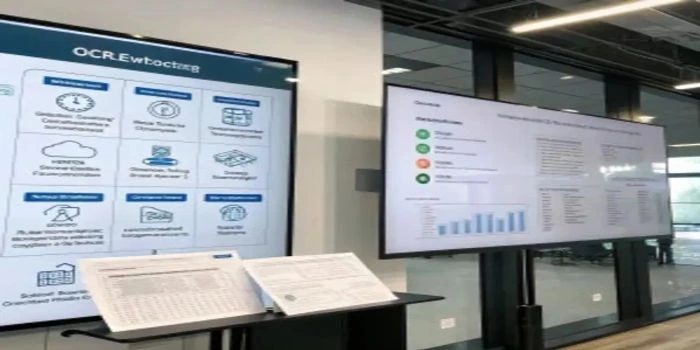20-22 Wenlock Road, LONDON, N1 7GU
20-22 Wenlock Road, LONDON, N1 7GU

Businesses are inundated with vast amounts of data. One of the most effective ways for enterprises to manage and extract valuable information from documents is through OCR data extraction. Optical Character Recognition (OCR) is a cutting-edge technology that can convert printed or handwritten text into a digital format, enabling enterprises to automate data extraction and streamline their workflows.
In this guide, we’ll delve into OCR data extraction, explore the various OCR technologies available, and highlight the key benefits enterprises can expect when implementing this solution.
OCR data extraction refers to the process of converting text from scanned images, PDFs, or other document formats into machine-readable text. It leverages OCR technology to recognize and extract data from documents like invoices, receipts, contracts, and more. By utilizing OCR data extraction software, businesses can eliminate the need for manual data entry, saving time and reducing errors.
Various types of OCR data extraction cater to different enterprise needs. Let’s take a closer look at them:
This is the most common type of OCR, focusing on extracting alphanumeric characters (letters and numbers). It’s ideal for digitizing simple text documents, forms, and books.
While more challenging, handwriting OCR extraction can read handwritten notes and convert them into machine-readable text. Advances in OCR technology have made this process more accurate, especially for specific industries like healthcare and finance.
This type of OCR data extraction software specializes in extracting information from barcodes or QR codes printed on documents or labels. It’s widely used in inventory management, shipping, and retail.
For enterprises that deal with large volumes of forms (e.g., surveys, applications, contracts), form OCR extraction allows businesses to automatically recognize and extract data fields from structured forms, such as names, dates, and addresses.
This type of OCR data extraction is used for converting scanned documents, including PDFs and images, into editable and searchable digital formats. It supports various document types, from legal agreements to financial reports.
OCR technology has evolved significantly over the years. Below are some key technologies that power OCR data extraction software:
Modern OCR technology integrates machine learning (ML) and artificial intelligence (AI) to improve accuracy and context understanding. AI models can train the software to read complex handwriting and various document layouts more effectively.
This involves identifying specific patterns in a document’s text or layout. Pattern recognition is crucial for documents with structured data, like invoices, as it helps OCR software identify where to extract particular pieces of information.
Cloud-based OCR solutions are becoming increasingly popular among enterprises, offering scalability, accessibility, and integration with other cloud applications. Cloud OCR solutions allow businesses to process documents remotely and access data from anywhere.
Implementing OCR data extraction can bring numerous advantages to businesses across various industries. Let’s explore the key benefits:
One of the most significant benefits of OCR data extraction is automation. By using OCR data extraction software, businesses can reduce the time spent manually entering data. This leads to faster processing times, enabling employees to focus on higher-value tasks.
The automation of data extraction eliminates the need for manual labor, thus reducing operational costs. By investing in OCR technology, enterprises can save on data entry expenses and improve resource allocation.
Human errors are inevitable when manually inputting data, but OCR data extraction minimizes mistakes by automatically scanning and extracting the required information. With advanced OCR technologies, accuracy rates can exceed 99%, leading to reliable data.
Converting documents into machine-readable text allows businesses to easily search and retrieve information. Rather than manually going through paper files, employees can quickly search for keywords, phrases, or specific data points, improving workflow and productivity.
OCR technology helps in digitizing and organizing documents for easy access and archiving. This ensures that all important business data is stored securely and can be retrieved anytime without physical limitations.
OCR data extraction software can help enterprises stay compliant with industry regulations by maintaining accurate, up-to-date records. Moreover, digital documents can be stored with encryption and restricted access, enhancing security.
As your enterprise grows, the volume of documents you need to process will likely increase. OCR data extraction is scalable, meaning that it can handle growing volumes of data without significant manual intervention.
While OCR data extraction offers numerous benefits, enterprises should consider several factors when selecting the right OCR software:
Incorporating OCR data extraction into your enterprise operations can bring substantial improvements in efficiency, accuracy, and cost savings. By understanding the types of OCR extraction available, the technologies that power it, and the benefits it offers, businesses can make informed decisions and implement solutions that streamline their document management processes.
As OCR technology continues to evolve, enterprises can expect even more advanced features, making OCR data extraction a cornerstone of future business operations.
OCR data extraction is the process of converting printed or handwritten text from documents into machine-readable digital data using OCR technology.
It scans documents, recognizes characters using OCR algorithms, and extracts structured data for digital processing and storage.
OCR can extract data from invoices, receipts, contracts, forms, handwritten notes, and even barcodes or QR codes.
It reduces manual work, improves accuracy, speeds up data processing, and enhances document searchability and compliance.
Yes, many OCR tools can integrate with CRMs, ERPs, and other business platforms for seamless data management.